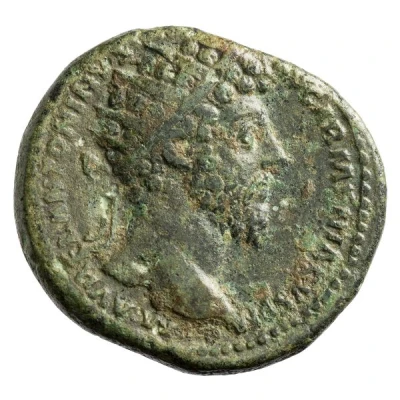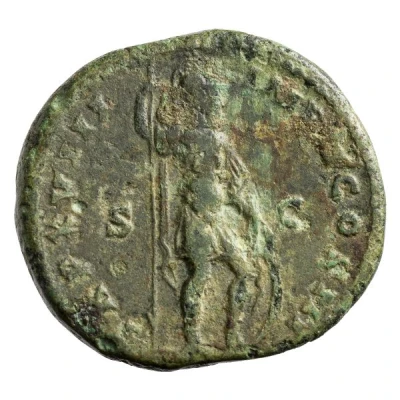


© Münzkabinett der Universität Göttingen (CC BY-NC 4.0 DE)
Dupondius - Marcus Aurelius TR P XVIII IMP II COS III S C; Mars
| Bronze | 13 g | - |
| Issuer | Rome › Roman Empire (27 BC - 395 AD) |
|---|---|
| Emperor | Marcus Aurelius (Marcus Aurelius Antoninus) (161-180) |
| Type | Standard circulation coin |
| Years | 163-164 |
| Value | 1 Dupondius = ⅛ Denarius |
| Currency | Denarius, Reform of Augustus (27 BC – AD 215) |
| Composition | Bronze |
| Weight | 13 g |
| Shape | Round (irregular) |
| Technique | Hammered |
| Demonetized | Yes |
| Updated | 2024-10-06 |
| Numista | N#263565 |
|---|---|
| Rarity index | 100% |
Reverse
Mars, helmeted, in military dress, standing right, holding vertical spear in right hand and resting left hand on round shield set on ground.
Script: Latin
Lettering: TR P XVIII IMP II COS III S C
Translation:
Tribunicia Potestate Octava Decima, Imperator Secundum, Consul Tertium. Senatus Consultum.
Holder of tribunician power for the 18th time, supreme commander (Imperator) for the second time, consul for the third time. Decree of the senate.
Comment
Mass varies: 12.95–12.958 g;Example of this type:
Münzkabinett der Universität Göttingen
Source:
Online Coins of the Roman Empire (OCRE)
Interesting fact
The Dupondius coin featuring Marcus Aurelius (TR P XVIII IMP II COS III S C; Mars) was part of a series of coins issued during his reign that depicted the Roman gods and goddesses. The coin's reverse side features a depiction of Mars, the Roman god of war, which was a common motif on coins during this period. This coin, in particular, is interesting because it shows Mars holding a spear and a shield, symbolizing the Roman Empire's military prowess and power. Additionally, the coin's obverse side features a portrait of Marcus Aurelius, who was known for his philosophical writings and his efforts to promote peace and stability within the empire. Overall, this coin provides a unique insight into the cultural and political climate of the Roman Empire during the 2nd century AD.